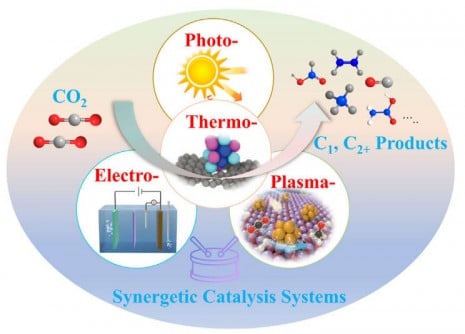Top Stories
Breakthrough in Carbon Recycling: Hybrid Catalysis Revealed

UPDATE: A groundbreaking review from the Shenzhen University of Advanced Technology has just been published, unveiling innovative pathways to enhance carbon dioxide (CO2) recycling. This urgent research, released in the May 2025 edition of the eScience journal, highlights the potential of hybrid catalytic systems to revolutionize CO2 reduction, a critical step toward achieving global carbon neutrality.
As the world grapples with climate change, the need for efficient CO2 reduction methods has never been more pressing. Traditional catalytic approaches, such as thermocatalysis and electrocatalysis, have faced significant limitations, including high energy consumption and low selectivity. This new study, co-authored by Professor Hui-Ming Cheng and Professor Xiaolong Zhang, emphasizes the necessity of exploring synergetic energy-coupled catalysis to overcome these hurdles.
The review categorizes advanced catalytic systems into three innovative types: photothermal, electrothermal, and plasma-thermal. These systems utilize multiple energy inputs—light, heat, and electricity—to enhance CO2 conversion efficiency significantly. For example, photothermal catalysis combines light and heat, maximizing solar energy use while reducing the high energy demands of standalone thermocatalysis.
Notably, catalysts like Au/ZnWO4-ZnO and Ni/TiO2 have exhibited impressive selectivity for CO2 hydrogenation under mild conditions, showcasing the effectiveness of this hybrid approach. Furthermore, electrothermal systems leverage resistive heating from electric currents, allowing catalysts to achieve necessary reaction temperatures in mere minutes, thus boosting efficiency and minimizing catalyst poisoning.
The research also highlights the potential of plasma-thermal coupling, which utilizes nonthermal plasmas to produce energetic electrons and radicals. This method, when combined with nanostructured catalysts, has achieved remarkable CO2 conversion rates at significantly lower energy costs. Case studies demonstrate that catalysts like β-Mo2C nanorods and plasma-assisted chemical looping can outperform conventional methods by threefold in conversion rates.
In a compelling statement, Professor Cheng remarked, “Single-mode catalytic strategies for CO2 reduction may have reached their performance limits. By leveraging the synergetic effects of combined energy inputs, we can access new reaction pathways, increase selectivity for valuable products, and significantly reduce energy consumption.” This innovative approach not only pushes the boundaries of catalytic science but also accelerates the deployment of technologies essential for carbon neutrality.
The implications of these findings are profound. By enhancing the efficiency and selectivity of CO2 reduction, these hybrid catalytic systems could lead to sustainable production of fuels like methanol and methane, as well as essential chemicals such as ethanol and acetic acid. If successfully scaled, they may bridge the gap between laboratory research and industrial application, providing a realistic solution to mitigate greenhouse gas emissions.
This research is not merely an academic exercise; it represents a critical step toward sustainable energy and carbon recycling solutions that could transform our approach to climate challenges. As governments and industries worldwide strive for long-term carbon neutrality goals, the integration of these advanced catalytic systems could hold the key to a cleaner, more sustainable future.
Stay tuned for more updates on this developing story as scientists continue to explore these innovative pathways for CO2 reduction. The future of carbon recycling is not just on the horizon; it’s unfolding right now.
-

 Science4 weeks ago
Science4 weeks agoALMA Discovers Companion Orbiting Giant Red Star π 1 Gruis
-

 Top Stories2 months ago
Top Stories2 months agoNew ‘Star Trek: Voyager’ Game Demo Released, Players Test Limits
-

 Politics2 months ago
Politics2 months agoSEVENTEEN’s Mingyu Faces Backlash Over Alcohol Incident at Concert
-

 World2 months ago
World2 months agoGlobal Air Forces Ranked by Annual Defense Budgets in 2025
-

 World2 months ago
World2 months agoMass Production of F-35 Fighter Jet Drives Down Costs
-

 World2 months ago
World2 months agoElectrification Challenges Demand Advanced Multiphysics Modeling
-

 Business2 months ago
Business2 months agoGold Investment Surge: Top Mutual Funds and ETF Alternatives
-

 Science2 months ago
Science2 months agoTime Crystals Revolutionize Quantum Computing Potential
-

 Top Stories2 months ago
Top Stories2 months agoDirecTV to Launch AI-Driven Ads with User Likenesses in 2026
-

 Entertainment2 months ago
Entertainment2 months agoFreeport Art Gallery Transforms Waste into Creative Masterpieces
-

 Business2 months ago
Business2 months agoUS Government Denies Coal Lease Bid, Impacting Industry Revival Efforts
-

 Health2 months ago
Health2 months agoGavin Newsom Critiques Trump’s Health and National Guard Plans









